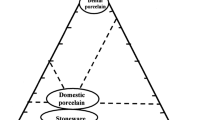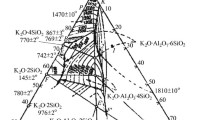The influence of wollastonites and marshallites on phase transformations and the processes leading to the formation of the mineral composition and structure of electrotechnical porcelain were determined. A positive dynamics of changes in the amount and ratios of crystalline and glassy phases as well as mullitization in bodies was established. Samples corresponding to the standards were obtained under laboratory conditions. The results will serve as a criterion for adoption in industry.





Similar content being viewed by others
References
V. I. Vereshchagin, V. V. Kozik, V. I. Syryamkin, et al., Multifunctional Inorganic Materials Based on Natural and Artificial Compounds [in Russian], Izd. Tomsk. Univer., Tomsk (2002).
L. M. Sulimenko and I. N. Tikhomirova, Fundamentals of the Technology of Refractory Nonmetallic Silicate Materials [in Russian], RKhTU im. D. I. Mendeleeva, Tomsk (2000).
I. Ya. Guzman, Chemical Technology of Ceramics [in Russian], Stroimaterialy, Moscow (2003).
M. E. Kurbanbaev, B. O. Esimov, T. A. Adyrbaeva, and V. I. Vereshchagin, “Electrotechnical porcelain based on mineral raw materials of the Republic of Kazakhstan,” Ogneup. Tekh. Keram., No. 4/5, 46 – 51 (2015).
M. E. Kurbanbaev, V. I. Vereshchagin, B. O. Esimov, and T. A. Adyrbaeva, “Selection of mineral raw materials and synthesis of porcelain for electrical purposes,” Izv. Nats. Akad. Nauk Resp. Kazakhstan, Ser. Geologii i Tekh. Nauk, No. 4(436), 238 – 245 (2019); URL: https://doi.org/10.32014/2019.2518-170X.119
M. E. Kurbanbaev, B. O. Esimov, and T. A. Adyrbaeva, “Kaolins of the Soyuznoye deposit as potential raw material for production of electrotechnical porcelain,” Fundam. Issled., No. 4, 88 – 92 (2015).
G. N. Maslennikova and T. I. Koneshova, “Effect of mineralizers on the sintering of porcelain bodies (a review),” Steklo Keram., No. 4, 13 – 15 (1987); G. N. Maslennikova and T. I. Koneshova, “Effect of mineralizers on the sintering of porcelain bodies (a review),” Glass Ceram., 44(4), 152 – 156 (1987).
M. I. Ryshchenko, E. Yu. Fedorenko, M. A. Chirkina, et al., “Microstructure and properties of low-temperature porcelain,” Steklo Keram., No. 11, 393 – 396 (2009); M. I. Ryshchenko, E. Yu. Fedorenko, M. A. Chirkina, et al., “Microstructure and properties of low-temperature porcelain,” Glass Ceram., 66(11 – 12), 152 – 156 (2009).
Yu. N. Kryuchkov, “Sintering particulars for ceramic materials,” Steklo Keram., No. 11, 29 – 34 (2013); Yu. N. Kryuchkov, “Sintering particulars for ceramic materials,” Glass Ceram., 70(11 – 12), 409 – 413 (2013).
Author information
Authors and Affiliations
Corresponding author
Additional information
Translated from Steklo i Keramika, No. 12, pp. 37 – 43, December, 2019.
Rights and permissions
About this article
Cite this article
Kurbanbaev, M.E., Vereshchagin, V.I., Esimov, B.O. et al. Electrotechnical Porcelain Using Native Fine Silica-Containing Raw Materials and Wollastonites. Glass Ceram 76, 468–473 (2020). https://doi.org/10.1007/s10717-020-00224-5
Published:
Issue Date:
DOI: https://doi.org/10.1007/s10717-020-00224-5




